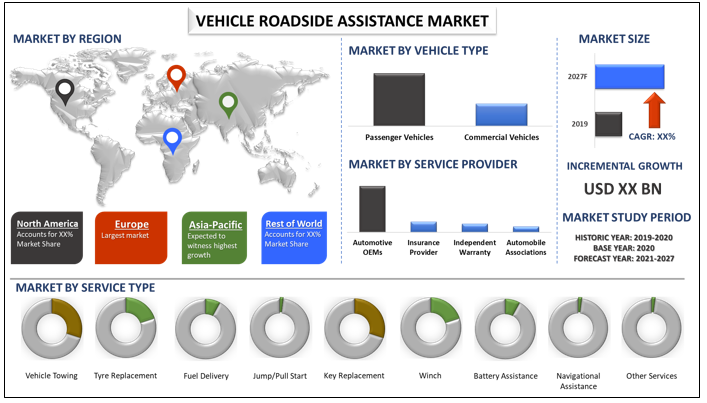In the dynamic landscape of the automotive industry, the realm of roadside assistance is undergoing a transformative journey, poised for a remarkable CAGR growth of more than 4% during the forecast period from 2021 to 2027. Vehicle breakdowns not only lead to traffic congestion but can also pose serious threats to lives. The aftermath involves not only the inconvenience of waiting for tow trucks but also disrupts schedules, wasting valuable time.
Access Sample PDF Here- https://univdatos.com/get-a-free-sample-form-php/?product_id=13158
The Essence of Roadside Assistance
Roadside assistance emerges as a beacon of hope, serving as an optional add-on to drivers’ personal auto insurance. This invaluable service extends a helping hand for a spectrum of issues such as flat tires, fuel deficits, battery failures, and towing, providing swift solutions to drivers in distress. In a world increasingly connected, vehicles are becoming repositories of vast amounts of data, offering a treasure trove of information that can redefine the landscape of roadside assistance.
Connected Vehicles: Transforming Assistance
Connected automobiles generate a wealth of data encompassing critical vehicle information such as location, engine status, error codes, fuel level, tire pressure, and more. This trove of data becomes the linchpin for roadside assistance service providers, enabling them to swiftly diagnose breakdowns, determine root causes, and facilitate faster response times. This not only enhances service quality but elevates the overall experience for the driver.
A Glimpse into the Canadian Landscape
Taking the spotlight in the realm of roadside assistance is the Canadian Automobile Association (CAA), boasting an impressive fleet of over 35,000 towing vehicles. A basic membership, starting at approximately US$75 per year, offers short-distance travelers up to five emergency calls, with towing covering 10 kilometers each call. For those seeking extended coverage, the Plus membership, priced at around $120, allows towing distances of up to a substantial 200 kilometers.
Browse Research Methodology, Report Description and Table of Content- https://univdatos.com/report/vehicle-roadside-assistance-market
Insights from the Report
1. Evolution of Services
Vehicle Towing Segment Leading the Charge
In the ever-evolving landscape of roadside assistance services, the Vehicle Towing segment emerges as the frontrunner, witnessing significant growth. While towing remains a cornerstone, other common breakdown causes include battery and alternator problems, flat tires, electrical issues, overheating, and mechanical failures related to the engine, transmission, or brakes.
2. Shifting Service Providers
Dominance of Automotive OEMs and the Rise of Insurance Providers
In 2020, Automotive OEMs took center stage as the dominant service providers. However, with the surge in user-based insurance, Insurance Providers are poised for substantial growth in the vehicle roadside assistance market.
3. Vehicle Types and Regional Dynamics
Passenger Vehicles at the Helm, Asia-Pacific on the Horizon
Currently, the demand for Vehicle Roadside Assistance predominantly stems from the Passenger Vehicles segment. However, the rising demand for connected vehicles is expected to fuel the need for roadside assistance services in the commercial vehicles segment. While Europe takes the lead in 2020, the forecast hints at the burgeoning growth of Asia-Pacific, with its dynamic economies and increasing adoption of connected technologies.
Navigating the Future
As we navigate the future of Vehicle Roadside Assistance Market, the road ahead is marked by innovation, data-driven solutions, and a commitment to delivering unparalleled service. The landscape is not just about fixing breakdowns; it’s about creating an ecosystem where drivers feel secure, supported, and empowered on every journey.
In a world where every second counts, roadside assistance is not just a service; it’s a lifeline.
Contact us:
UnivDatos Market Insights (UMI)
Email: [email protected]
Ph: +91 7838604911


